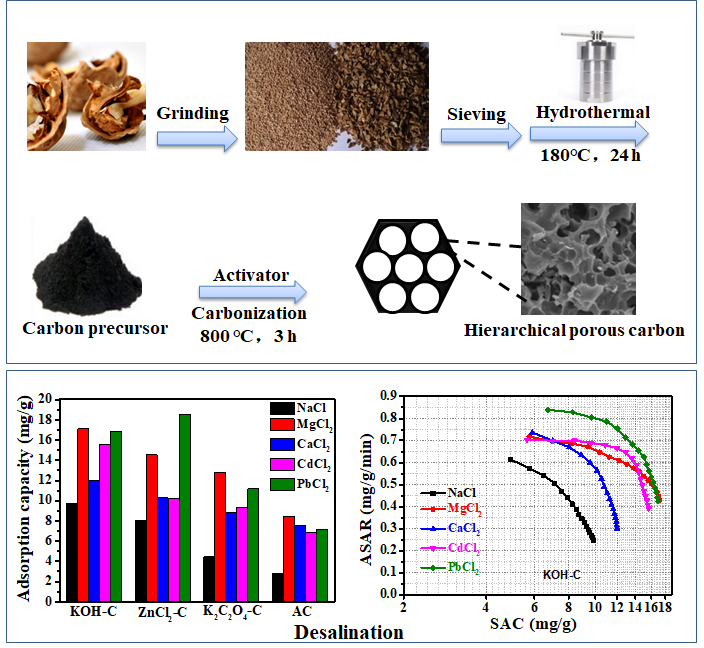Enhanced capacitive deionization of toxic metal ions using nanoporous walnut shell-derived carbon
Zheng Cao a, 1, Shen Hu a, 1, Jian Yu a, Luyao Wang a, Qi Yang a, Haiou Song b, *, Shupeng Zhanga, *
Abstract
Capacitive deionization (CDI) technology differs from traditional demineralization technology. Its desalination effect is mainly dependent on the electrode material and the porous nanostructure which can enhance capacitive deionization performance. Here, a low-cost and eco-friendly CDI technology has been developed to remove divalent ions from water. Using different activators such as KOH, ZnCl2 and K2C2O4 to reconstruct the biomass carbon skeleton, porous carbon material derived from walnut shells was used as symmetric electrodes. The maximum removal capacities in the CDI electrosorption were 17.1 mg/g for Mg2+, 11.99 mg/g for Ca2+, 18.56 mg/g for Pb2+ and 15.52 mg/g for Cd2+. The best effect on formation of micropores and construction of adsorption channels was observed using KOH as activator. The KOH-C had a specific surface area of 1600.34 m2/g and a cumulative pore volume of 0.3561 cm3/g, which provides favorable conditions for ion storage. These results demonstrate that KOH-activated carbon biomass can improve electrosorption performance and has potential as an advanced, inexpensive electrode material for capacitive deionization.
In this work, we have used electrodes prepared from waste walnut shells activated by KOH, ZnCl2 and K2C2O4 for electrosorption of different metal ions. Images from SEM and TEM confirmed that the biomass had a fluffy porous network structure. From the Brunauer-Emmett-Teller (BET) test and calculation of the pore size distribution, KOH-C, ZnCl2-C, and K2C2O4-C all exhibited ideal mesoporous structures, while average adsorption pore sizes of KOH-C and ZnCl2-C were smaller, indicating that these activators induced a larger amount of microporous structure. In terms of electrochemical performance, K2C2O4-C had the highest specific capacitance due to the presence of more sites distributed on its surface. In the CDI experiments, porous carbon material was used as symmetric electrodes and achieved maximum capacities of 17.1 mg/g for Mg2+, 11.99 mg/g for Ca2+, 18.56 mg/g for Pb2+ and 15.52 mg/g for Cd2+ removal. The adsorption capacities and rates of all the materials for divalent ions were higher than those for monovalent sodium ions. The comprehensive adsorption capacity of KOH-C for different ions was highest and its regeneration performance was also relatively good, indicating its potential as a promising electrode material for future CDI applications and paving the way to eliminate multiple inorganic contaminants from waste water.

转载本文请联系原作者获取授权,同时请注明本文来自张树鹏科学网博客。
链接地址:https://wap.sciencenet.cn/blog-311896-1346321.html?mobile=1
收藏


